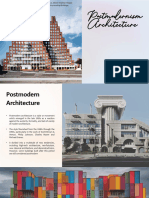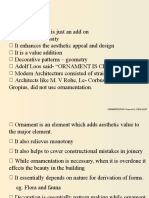0% found this document useful (0 votes)
256 views6 pagesArchitectural Ornamentation History
Ornamentation in architecture refers to applied embellishments that distinguish buildings. Ornamentation is often seen on columns, entablatures, and around windows and entryways in the form of moldings. Throughout history, ornamentation had symbolic meaning and was important in antiquity, the Renaissance, and religious buildings. However, the Modern Movement disrupted the link between ornament and architecture by featuring unornamented facades. Still, there are examples of Modern architecture that incorporate traditional materials and ornamentation. The use of ornamentation relates to the meanings and priorities of different historical eras.
Uploaded by
Poorvi M PCopyright
© © All Rights Reserved
We take content rights seriously. If you suspect this is your content, claim it here.
Available Formats
Download as PDF, TXT or read online on Scribd
0% found this document useful (0 votes)
256 views6 pagesArchitectural Ornamentation History
Ornamentation in architecture refers to applied embellishments that distinguish buildings. Ornamentation is often seen on columns, entablatures, and around windows and entryways in the form of moldings. Throughout history, ornamentation had symbolic meaning and was important in antiquity, the Renaissance, and religious buildings. However, the Modern Movement disrupted the link between ornament and architecture by featuring unornamented facades. Still, there are examples of Modern architecture that incorporate traditional materials and ornamentation. The use of ornamentation relates to the meanings and priorities of different historical eras.
Uploaded by
Poorvi M PCopyright
© © All Rights Reserved
We take content rights seriously. If you suspect this is your content, claim it here.
Available Formats
Download as PDF, TXT or read online on Scribd
/ 6






























































































